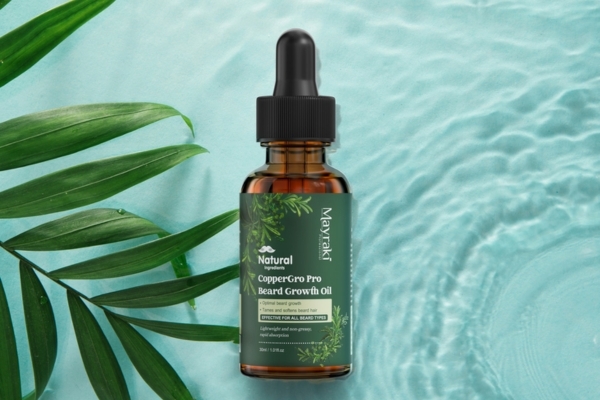How to Protect Your Beard from Chlorine Damage: Swim Without Sacrificing Facial Hair
Nov 18, 2025 | By Maria Eliza Pineda

Swimming is a fun way to stay active and relax, but when you have a beard, it can become a silent enemy. You can dive into the pool, but your beard doesn’t have to pay the price. Chlorine in swimming pools is known to strip natural oils, dehydrate facial hair, and cause brittleness, frizz, and weakened beard strands. If you regularly swim or are often exposed to chlorinated water, it’s essential to understand proper beard chlorine damage protection to keep your beard healthy, smooth, and strong.
How Chlorine Damages Beard Hair
Chlorine is an oxidizing agent used in pools to kill bacteria, but on beard hair, it causes serious damage. First, it strips away the natural oils responsible for keeping your beard and the skin beneath it hydrated. Once these oils are removed, beard hydration loss occurs, resulting in dryness and itchiness. Second, chlorine opens up the hair cuticle, making it more porous and vulnerable to chemical damage. Over time, the beard fibers weaken, leading to breakage and split ends. For those with lighter or porous beard hair, discoloration may happen, sometimes even turning a pale or slightly greenish color. Without beard care for swimmers, the beard can eventually become rough, frizzy, and difficult to manage.
Before Swimming: Protective Steps
Saturate with Fresh Water
Before jumping into the pool, thoroughly wet your beard with fresh, non-chlorinated water. When the beard hair is already filled with clean water, it absorbs less chlorinated water. This simple but effective step reduces chlorine absorption and prevents excessive stripping of natural oils.
Apply a Barrier or Protective Layer
After soaking your beard, apply beard oil as your first line of defense. Use an oil like CopperGro Pro Beard Growth Oil, which not only creates a hydrophobic barrier but also provides nutrients and fatty acids that keep the hair strong and soft. Warm the oil in your palms, massage it into the skin and beard, and comb through to distribute evenly. For added sealing, you can top it with a light balm or butter.
Style or Tie the Beard (If Long)
If you have a long beard, loosely tying or braiding it helps minimize exposure and water drag. If possible, use a swim cap or face covering that can also protect the beard.
Exposure Tips

While swimming, try to limit long periods of beard submersion. During breaks, splash fresh water on your beard to dilute chlorine contact if available. Avoid repeatedly dunking your face, as constant wet-dry cycles increase chlorine buildup within the beard shaft.
After Swimming: Recovery & Restoration
Rinse Immediately with Fresh Water
As soon as you get out of the pool, rinse your beard with cool or lukewarm water to remove chlorine and chemicals stuck on the hair strands. The sooner you remove the residue, the less oxidative damage it can cause.
Use a Clarifying or Residue-Removing Beard Wash
Use a clarifying yet sulfate-free beard shampoo that can remove chemical buildup without excessively stripping remaining natural oils. Gently lather it and massage it from the skin to the tips.
Condition & Rehydrate
After cleansing, restore hydration using a beard conditioner or deep treatment. This step is crucial for reversing moisture loss caused by chlorine. If it’s a leave-in product, let it stay; if it’s rinse-out, only lightly rinse it to retain hydration.
Reapply Beard Oil
Once conditioned, reapply the MayrakiCopperGro Pro Beard Growth Oil to seal in moisture, strengthen the cuticle, and begin the beard recovery process. Comb it through for even distribution and softness.
Maintenance and Long-Term Strategies
Beard care in chlorinated water is not a one-time process, it requires consistency. Use clarifying washes once a week to remove residual chemicals. Incorporate antioxidant-rich oils or serums to combat oxidative stress. Trim regularly to remove weakened or split ends. If available, use protective swim gear. Always monitor your beard’s texture and adjust your routine if signs of dryness or brittleness appear.
How the Mayraki CopperGro Pro Beard Growth Oil Fits In

The Mayraki CopperGro Pro Beard Growth Oil is essential to your chlorine-safe beard routine. Before swimming, it acts as a beard barrier oil, helping reduce chlorine penetration. After swimming, it functions as a restorative treatment that delivers nutrients and lipids to repair the hair cuticle and reinforce beard structure. With consistent use, it helps repair chlorine damage and prevents thinning and weakening over time.
Common Mistakes and Troubleshooting
Many people fail at beard chlorine damage protection due to simple oversights. One of the most common mistakes is failing to rinse before or after swimming, allowing chlorine to linger and cause deeper damage. Using harsh shampoos can further strip natural oils. Overusing beard oil can cause clogged pores and greasiness. Avoiding trims allows damaged hair to accumulate, making the beard appear more unhealthy. Frequent swimming without breaks or protection accelerates damage further.
Splash Around Without Fear
Your beard doesn’t have to suffer just because you love swimming. With proper protection, a consistent routine, and the use of restorative products like the Mayraki CopperGro Pro Beard Growth Oil, your beard can stay thick, healthy, and resilient even with frequent pool exposure. Start your chlorine-safe beard care routine today, swim confidently, and let your beard stay strong, smooth, and proud in every dive.




